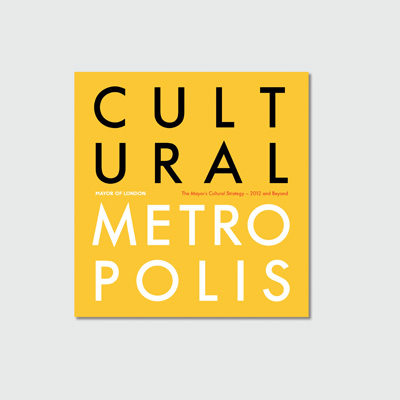A rebalancing act
The Mayor of London has previously championed the role of public investment in developing the capital’s cultural life, but a new strategy document hints at a cost-driven change of approach. Tom Banks looks at the implications for design

Mayor of London Boris Johnson set out his cultural strategy review last week pledging continued investment in creativity, yet creative and cultural bodies in the capital face an uncertain future, with both Design for London and the London Development Agency facing the axe.
Cultural Metropolis – the mayor’s cultural strategy – claims to set out Johnson’s ’vision, priorities, and recommendations’ for the capital’s cultural future, but defines this through intention, rather than policy.
’Investment in ideas pays off,’ says Johnson, promising, ’This investment comes from a mixture of private and public sources, and we need both to continue. We should never be in a position where Londoners fear that it is too costly to have creative ideas.’
DfL, the LDA and many other design bodies and organisations will have their fate decided not by this cultural strategy, but by what Johnson intends to do with his new budget in the wake of the Government’s Comprehensive Spending Review.
A spokesman for the Mayor’s Office says that the real impact will be known after Johnson’s budget has been decided.
The spokesman says, ’The mayor expects the Government to shortly set out the details of a single budget that will be made available to him for the economic development of the capital. Under these new measures, the mayor will also be able to identify where costs can be reduced on current programmes and savings reinvested.
’Once we know these details we will be able to plan how to best deliver on the mayor’s priority projects, including promoting London abroad.’
The LDA is the mayor’s agency for driving sustainable economic growth. It supports a variety of other organisations and projects which invest in regeneration and improve public spaces.
DfL is entirely reliant on the LDA for funding and, on behalf of the mayor, looks to ensure a design-led approach to delivering improvements to infrastructure and the built environment in the capital.
A spokesman for the LDA expects to know in two weeks if the LDA and DfL can – as the mayor indicated in June – somehow be ’folded’ into the Greater London Authority.
He confirms that the organisation will be disbanded by the end of March 2012 and that all staff are in consultation as the LDA reduces staffing levels by two thirds by March 2011.
Investment in ideas pays off. This investment comes from a mixture of private and public sources, and we need both to continue. We should never be in a position where Londoners fear that it is too costly to have creative ideas
Boris Johnson, Mayor of London
There are ’various proposals’ being mooted which would see the LDA’s functions saved, the spokesman says. ’One route is that we would combine with Land Assets to form a new regeneration body.’
A spokesman for the Mayor’s Office would only say that the GLA is in ’intense negotiations’ with the Government ’to ensure that key mayoral priorities currently carried out by the LDA continue after its reorganisation’.
Interestingly, the cultural strategy shows the GLA to be moving away from the idea of the LDA as a source of cultural support, instead suggesting its value as an economic driver.
The Cultural Metropolis strategy document states, ’Unlike his transport or economic development strategies, the mayor does not have the equivalent of Transport for London or the LDA to lead on [the cultural strategy’s] implementation.’
It continues, ’Indeed, no single delivery agency for culture in London exists. Nor is the GLA a major direct funder of the cultural sector in London – there are already many such agencies in London, charged with allocating National Lottery revenues and other public funds.’
It seems that private sector revenue streams will have to play a greater role in London’s design and cultural innovation.
Graphic designer Neville Brody has already announced plans for an ’Alternative Arts Council’, which would aim to channel corporate funding into UK arts initiatives and plug the gap left by cuts to Arts Council England (www.designweek. co.uk, 15 November).
However the strategy document calls on Government and private industry to protect the arts, in spite of austerity measures.
It stresses that London’s creative economy generates £18bn per year, and Johnson is openly putting pressure on Government and local councils to somehow make up any shortfall.
In the report, Johnson says, ’Creative thinking and innovation are vitally important to the health and wealth of this great city and that is exactly why I am advocating, through my cultural strategy, that continued support and investment in the creative economy is crucial to sustaining the wellbeing of London and the nation.’
As GLA departments prepare for potential budgetary constraints, there are signs that the uncertainty may be freezing live design projects. Neither the Mayor’s Office or Saffron Brand Consultants were able to comment on the status of a competition the consultancy won in January to create a visual identity for London.
Saffron was appointed ahead of shortlisted finalists Studio Conran and Dragon Rouge to win the GLA competition, but the design is yet to be implemented, nearly a year later.
London’s cultural arsenal
- 22 national museums and more than 200 other museums
- 12 specialist arts and culture higher education institutes
- Tate Modern – the world’s most popular art gallery
- 40 000 listed buildings and more than 150 ancient monuments
- Four Unesco world heritage sites – Tower of London, Maritime Greenwich, Westminster Palace and Kew’s Royal Botanic Gardens
-
Post a comment




